If I was to tell you about a national park in Victoria that sits on top of a volcano, is on the edge of an ancient 350km lava flow that’s one of the largest in the world, and has rock formations unlike anything else in the country, where would you think it was?
Whatever your answer, it probably wouldn’t be “the outskirts of Melbourne”, and yet that’s exactly where you’ll find Organ Pipes National Park. This family-friendly park is the perfect way to spend an hour or two in nature without having to travel very far, and despite its small size, there’s plenty to see and do while you’re there.
Whether you’re looking for the basalt columns that give the park its name, a peaceful stroll beside a gently-flowing creek, a bit of wildlife spotting, or just a good place to have a picnic among natural surroundings, you’re in for a treat. Here’s everything you need to know to plan your visit!
Getting To and From the Park
Located in Keilor North, the park is less than 25km northwest of the Melbourne CBD, just off the M79 freeway. Depending on exactly where you’re starting from, it’s about a half-hour drive to get there. Look out for the signposts to the park when you get close: if you’re coming from Melbourne, you’ll need to get into the right turning lane and wait for a gap in traffic to cross the freeway into Organ Pipes Road.
There’s plenty of parking just after you enter the park; we last visited on a Sunday morning and there were only a few other cars around when we arrived at 9:30am. When we left a couple of hours later, the carpark was getting more full, but there were still several empty spaces.
If you’re reliant on public transport, you can get close to Organ Pipes by train and bus, but not the whole way. Take the Sunbury line from Southern Cross to Watergardens: from there, it’s about 5km in an Uber to and from the entrance of the national park.
Getting Around the Park
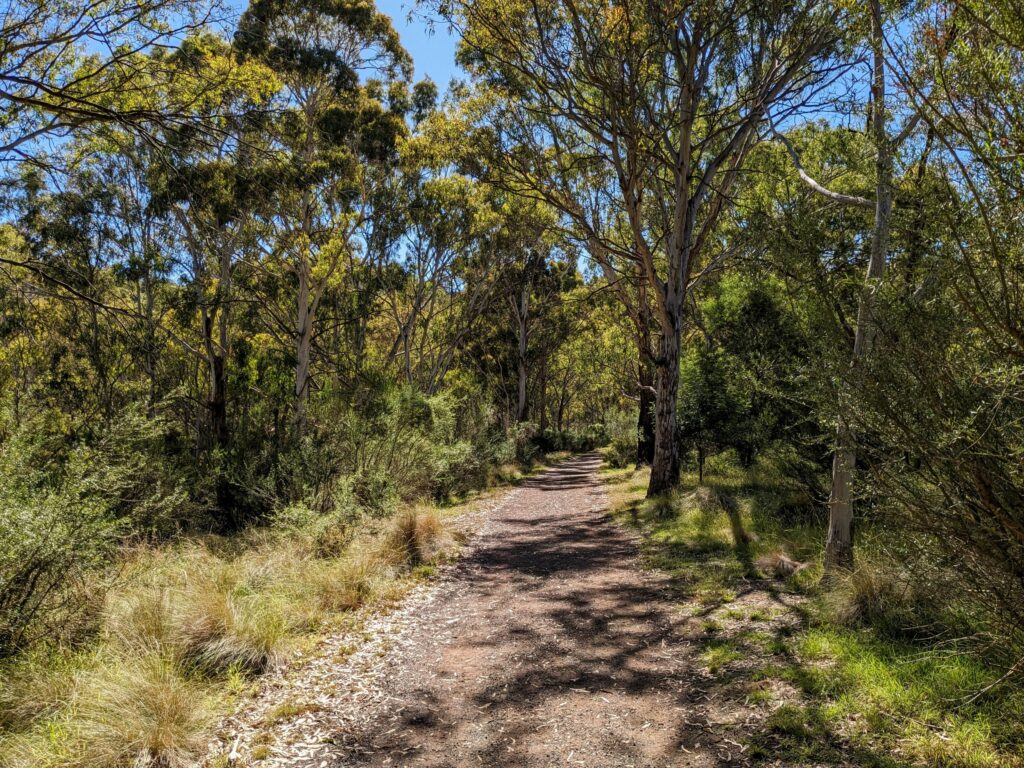
Organ Pipes National Park is fairly small, and the part that’s of interest to most visitors smaller still. A steep 700m bitumen path runs from the carpark down into the valley that holds all of the park’s attractions: climbing back up this section at the end will be by far the most strenuous thing you do while you’re there! There are no stairs or steps on the paved section of path, but the incline is enough to make it unsuitable for wheelchairs, and you’d have a hard time with a stroller or pram as well.
The three primary trails all join at the Organ Pipes picnic area, with the sealed track you’ve just walked down marked as the Organ Pipes Trail. Turn left at the end and you’ll find yourself on the Left River Trail, turn right and shockingly enough, you’ll be on the Right River Trail.
There are plenty of signs around to point you in the right direction, but with only three main things to see that are all within a fairly short walk of each other, it’s pretty hard to get lost. You can download a PDF map and brochure from Parks Victoria.
Side trails branch off in different directions, but most of them either reconnect with the main trails a bit further along, or eventually stop at an obvious dead-end. The surface becomes light gravel or dirt once you get down into the valley, with a rocky section on and around the Tessellated Pavement.
About halfway down the path from the carpark, a shortcut trail branches off to the left towards Rosette Rock. It doesn’t make much difference which way you go, but I usually take the shortcut, checking out the rock and Tessellated Pavement before turning around and heading back to the Organ Pipes. That’s mainly so that I can finish at the picnic area and have somewhere to sit with a drink and a snack at the end before climbing back up the hill.
Planning Your Trip
Because of the small size of the park, it’s not somewhere you need to spend all day at. We usually take a couple of hours to visit the three main sites and have a leisurely stroll along some of the side trails; add another hour or so if you’d like to have a picnic lunch as well.
There are two picnic areas in the park, a fancy new one at the top beside the visitor centre and carpark, and an older one beside the famous rock formation. Both have toilets and several shaded tables, and there’s a water fountain at the top with drinkable water. Water at the lower picnic area is for handwashing only, and isn’t safe to drink.
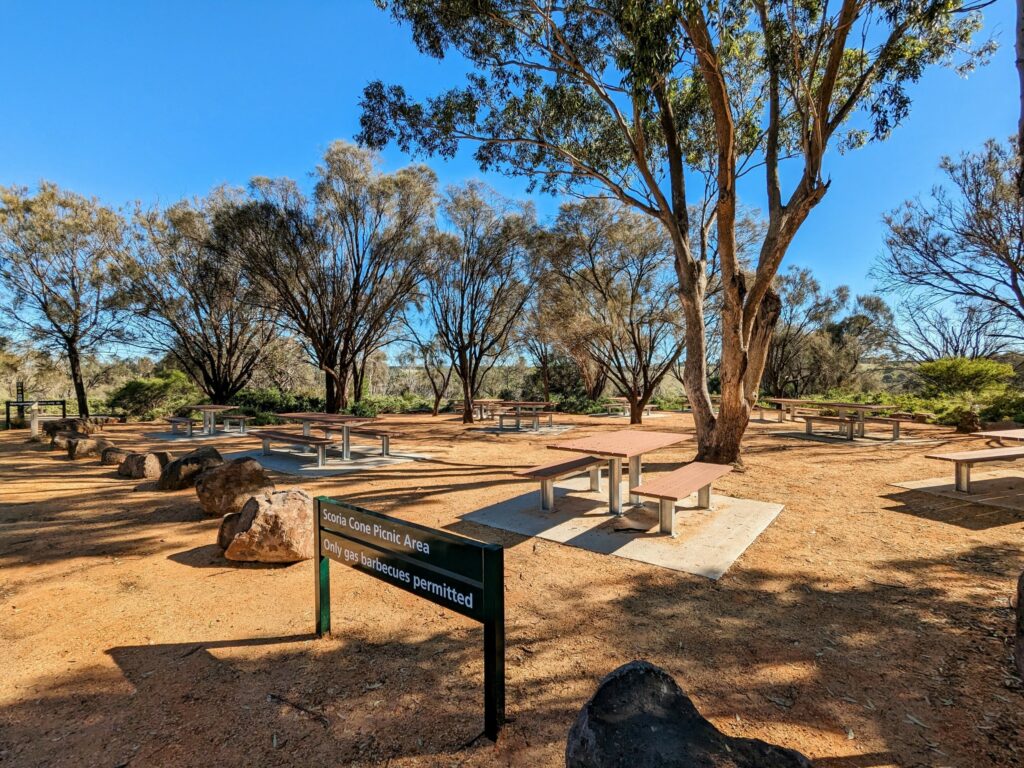
The park is open from 8:30am until 6:30pm during the warmer months, dropping back to a 4:30pm closure outside daylight savings time. There’s no cost to enter or park at Organ Pipes National Park.
As with any outdoor activity in Victoria, dress and pack appropriately for the weather. That means a sunhat, sunscreen, and plenty of water in the hotter months, and warm clothes if you’re visiting in winter. Drop a light jacket in your bag if there’s a chance of rain, and wear shoes that are comfortable to walk a few kilometres in, including the steep path to and from the carpark.
Like most national parks in Australia, there’s plenty of wildlife that lives here, including some that you probably don’t want to make the acquaintance of. Snakes are common, especially around the Tessellated Pavement: avoid walking through long grass and undergrowth, and make enough noise that they know you’re coming and can move away from you. I’ve seen lots of bull ants in the park as well; their stings are very painful, so look around before you sit down!
What to See and Do While You’re There
While that famous rock formation is the star of the show, it’s not the only reason to visit Organ Pipes National Park. The area’s volcanic past has left its mark throughout the park, there’s plenty of opportunity to spot native wildlife, and quiet side trails offer some peace and quiet away from the main attractions.
Rosette Rock

About halfway along the Left River Trail sits the Rosette Rock, a collection of large basalt columns on the other side of Jackson’s Creek that radiate out like the spokes of a wheel. That’s the theory, at least: I’m not sure I could really see it from my vantage point at ground level, but it’s worth a quick look regardless.
There used to be a viewing platform installed here, but flooding and subsidence caused enough damage that it’s been fenced off and awaiting replacement for a few years now. You can still see and take photos through the chain-link fence, and there’s a good viewing spot to the right of the fence: just watch out for snakes in the grass if you decide to get closer.
Tessellated Pavement
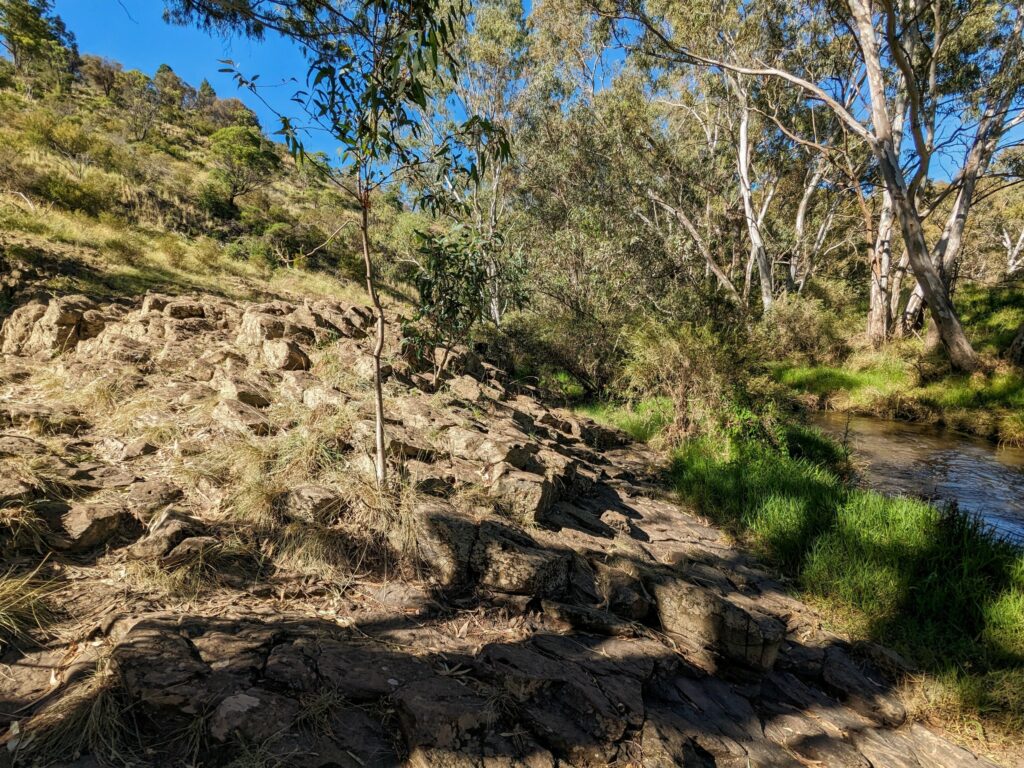
At the far end of the Left River Trail sits the Tessellated Pavement, a long series of basalt columns alongside each other that have been worn down by Jackson’s Creek over the millennia. They resemble a mosaic, and stretch for about a hundred metres along the current path of the creek, rising gently as they go.
Start beside the creek and walk around on top of the “pavement” until the rocks turn to grass and bushes, then drop down to follow the narrow trail alongside. It looks like the path ends soon after, but keep on going: it opens up again almost immediately, and you’ll find yourself now standing alongside the columns rather than on top of them.
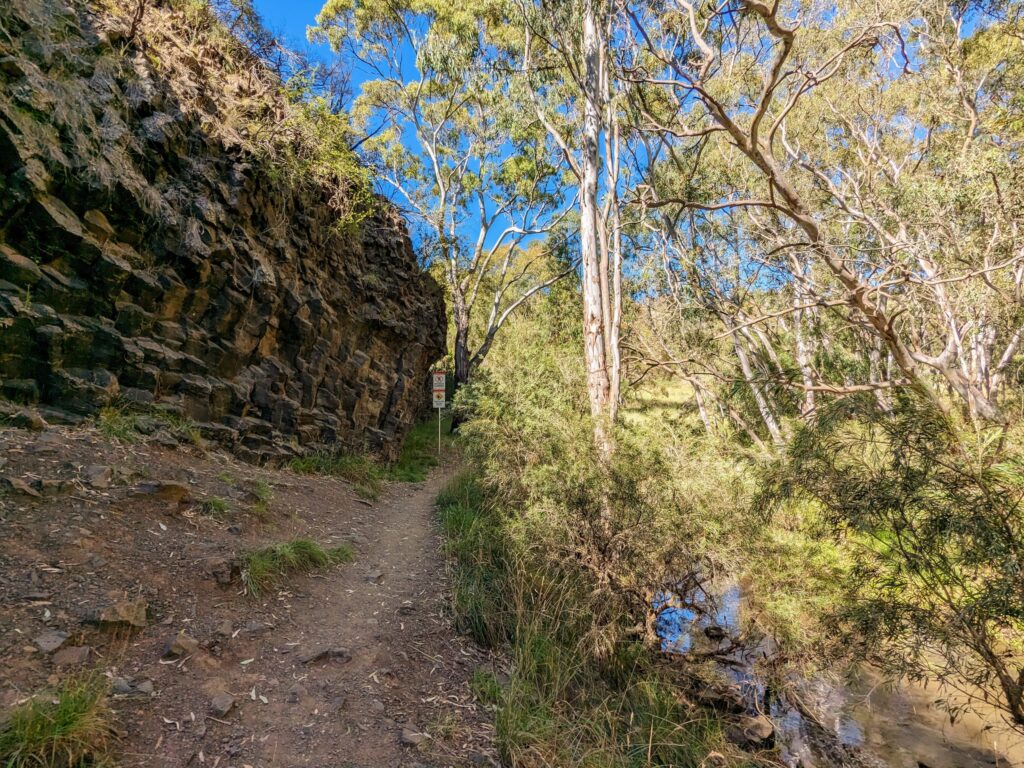
This is where the Left River Trail officially ends, but it’s definitely worth continuing along the now-unnamed track as it follows the curves in the creek for another few hundred metres. Most people don’t come down here, so it’s more peaceful than the rest of the park. The trail meanders away from the creek for a while through grass and trees: keep an eye out for the spot about halfway along this section where you can detour back to the creek bank for a lovely view.
After a few minutes the trail stops at a dead end as you get close to the park boundary. You can get down to the creek here as well, but other than a few rocks, there’s not a lot to see; just retrace your steps when you’re done. Once you get back to the Tessellated Pavement, just follow the Left River Trail all the way back towards the park’s star attraction: Organ Pipes.
Just before you get there, be sure to stop at an open area on the banks of the creek, right beside the trail. Large overhanging trees cast plenty of shade and provide handy exposed roots to use as seats if you’d like to sit for a while. If there aren’t many other people around, I’d recommend doing just that: the sound of water running over the little rapids nearby makes this a lovely spot to relax for a few minutes.
Organ Pipes
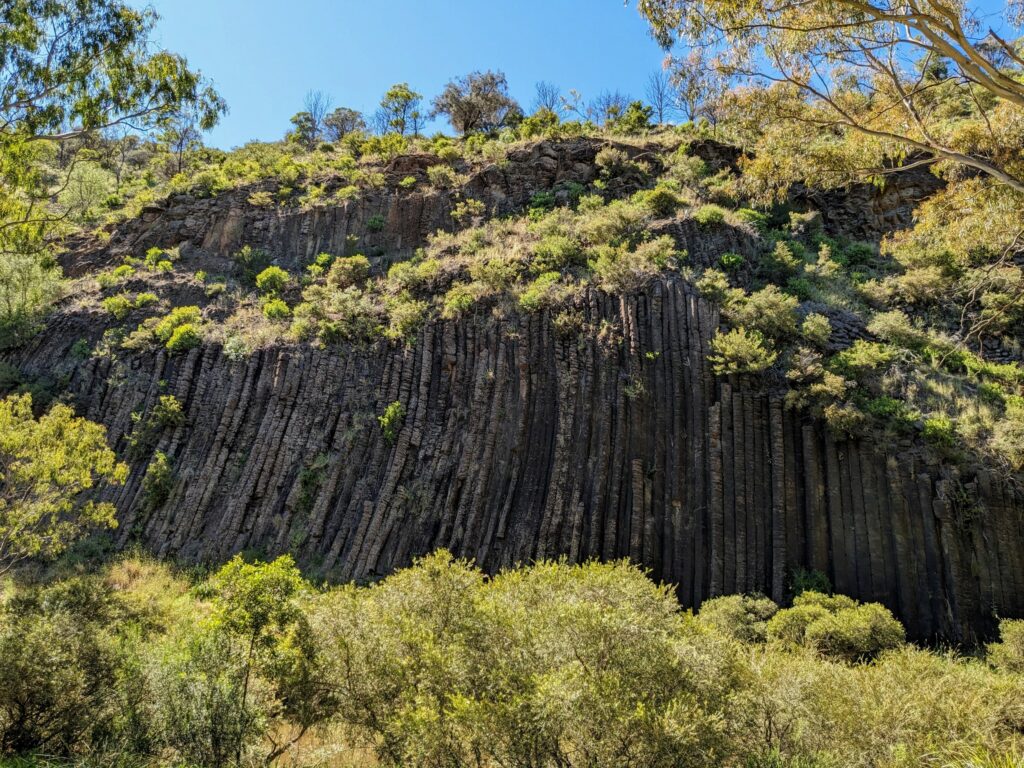
Rosette Rock and the Tessellated Pavement are both worth the small effort needed to see them, but they’re not the reason people come to the park. That reason, of course, is the Organ Pipes themselves, a collection of hundreds of thin columns rising 20m up the side of a cliff that runs alongside Jackson’s Creek. I’ve never seen anything quite like it anywhere else in the world, so to have them this close to Melbourne feels like a real treat.
It’s that placid-looking creek that’s revealed the pipes in the first place, quietly wearing down the basalt cliff over the million years or so since lava from a nearby volcanic eruption flowed through here and filled the valley. You can see the pipes from a few different spots along the opposite bank of the creek, but there’s a small viewing area at the end of the paved path that’s a good place to start.
When you’re done viewing the rock formation, follow the dirt path to your right. This is the Right River Trail, which runs for around 300m through the trees until it stops at a seasonal river crossing. If it’s been particularly dry you might be able to rock-hop across here without getting your feet (too) wet and join up with a 4WD track to go a bit further, but otherwise this is the end of the trail: feel free to take advantage of the nearby seat if you need it!
In theory there’s a steep dirt trail that runs from here up the side of the hill and comes out back at the visitor centre, but if it still exists, it’s too overgrown for me to spot it. Unless you have better eyes than me, just head back the way you came towards the Organ Pipes and picnic area. This is the ideal spot to stop for a drink and something to eat, with plenty of tables and a toilet if you need it.
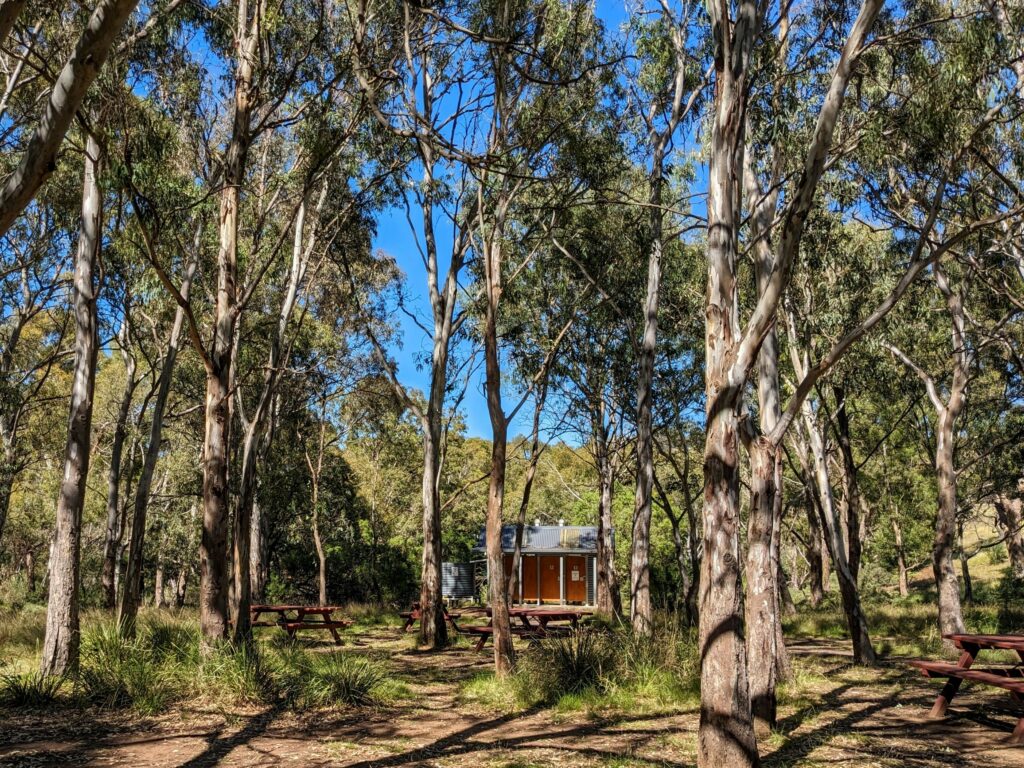
Wildlife Spotting
Earlier I mentioned a couple of animals that you don’t necessarily want to see while you’re in the park, but luckily there are many others living there that you probably do! Depending on the time of day and how many other people are around, it’s pretty common to see wallabies and kangaroos near the trail or on the other side of the creek.
Echidnas roam the path as well, and if you’re very lucky, you might even spot a wombat or a platypus late in the day. Smaller animals are everywhere, with frogs, sugar gliders, several species of birds, and lots of lizards living in the park.
Q&A
To finish off, here are the answers to a few questions about Organ Pipes National Park that I haven’t answered elsewhere in the post!
No, dogs are prohibited in most national parks in Victoria, including Organ Pipes.
It really depends on the time of year: on hot summer days, earlier is better, as there isn’t a lot of shade on some of the trails and the steep climb back up to the carpark gets harder as the temperature rises. It matters less at other times of year. The only thing worth noting is that the sun rises behind the organ pipes rock formation, so sun glare can be an issue in your photos until mid to late morning.
There are no inbuilt BBQs in the park, but you are allowed to bring and use a gas BBQ in the picnic areas at either end of Organ Pipes Trail. Wood or other solid-fuel fires can’t be used in the park.
You should be able to just put the name of the park into most GPS systems, but if you need an address, use Organ Pipes Road in Keilor North.
No. There are no camping areas or facilities in the park, and staying overnight isn’t permitted.
If there’s anything else you’d like to know, just drop it in the comments!
All images copyright Everything Victoria
